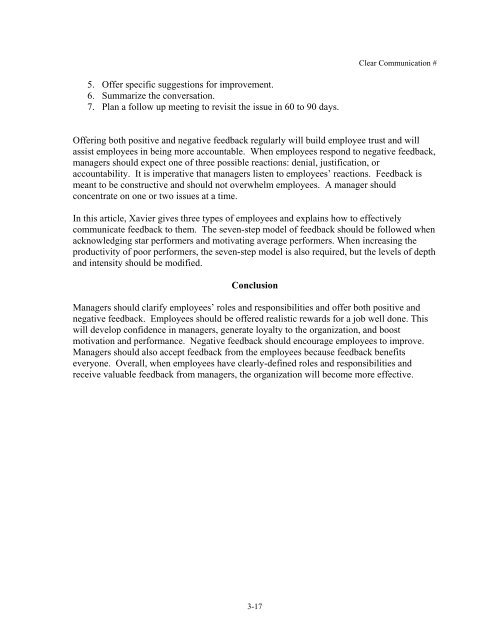Ohio University College of Business Communication Standards
Ohio University College of Business Communication Standards
Ohio University College of Business Communication Standards
Create successful ePaper yourself
Turn your PDF publications into a flip-book with our unique Google optimized e-Paper software.
5. Offer specific suggestions for improvement.<br />
6. Summarize the conversation.<br />
7. Plan a follow up meeting to revisit the issue in 60 to 90 days.<br />
Clear <strong>Communication</strong> #<br />
Offering both positive and negative feedback regularly will build employee trust and will<br />
assist employees in being more accountable. When employees respond to negative feedback,<br />
managers should expect one <strong>of</strong> three possible reactions: denial, justification, or<br />
accountability. It is imperative that managers listen to employees’ reactions. Feedback is<br />
meant to be constructive and should not overwhelm employees. A manager should<br />
concentrate on one or two issues at a time.<br />
In this article, Xavier gives three types <strong>of</strong> employees and explains how to effectively<br />
communicate feedback to them. The seven-step model <strong>of</strong> feedback should be followed when<br />
acknowledging star performers and motivating average performers. When increasing the<br />
productivity <strong>of</strong> poor performers, the seven-step model is also required, but the levels <strong>of</strong> depth<br />
and intensity should be modified.<br />
Conclusion<br />
Managers should clarify employees’ roles and responsibilities and <strong>of</strong>fer both positive and<br />
negative feedback. Employees should be <strong>of</strong>fered realistic rewards for a job well done. This<br />
will develop confidence in managers, generate loyalty to the organization, and boost<br />
motivation and performance. Negative feedback should encourage employees to improve.<br />
Managers should also accept feedback from the employees because feedback benefits<br />
everyone. Overall, when employees have clearly-defined roles and responsibilities and<br />
receive valuable feedback from managers, the organization will become more effective.<br />
3-17




